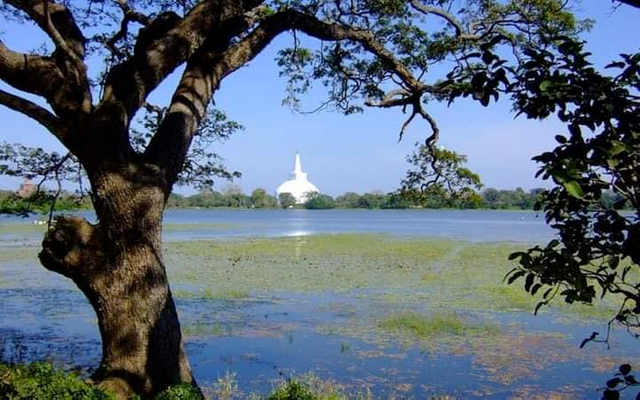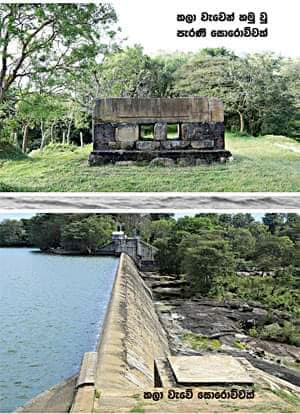• Hela irrigation technology and aspects of a lake.
• Hela irrigation technology and aspects of a lake.
Legends in the North Central Province reveal that the people of the Yaksha tribe who lived in Lakdi before the Aryagamana knew about building lakes and agriculture. The beginning of the Sinhala national culture is the lake. A lake is not a single context. The lake has been created by the combination of various elements. The original colonists of this country were converted into natural reservoirs known as "lakes". Many lakes were created by the past kings for the welfare of the people.

The lake, which was a fundamental part of the village then and now, has become a main factor that gives life to the village and makes it shine. The information about the early years of that period has been collected only in the Mahavamsya and the related books.
King Parakramabahu is said to have vowed that every drop of water that falls from the sky would not go to waste instead of sending it to the farming fields. Many kings who worked for the welfare of the people followed this practice. King Mahasen, who made the Minihiriya, Mugagamuwa, Ratnatisa, etc. lakes solo, was given the name "Mahasen Devi". It is reported that King Dhatusena, before his death, went down to the art lake, which he cherished with all his life, and said, "This is the treasure I have collected." At that time, it was mandatory for every king who became the leader of the state to support the Buddhist religion as well as the irrigation industry.
Even today's scientists are surprised by the alternative and technical knowledge possessed by the Sinhalese who lived at that time when studying our ancient water supply business. The canal called "Jaya Ganga" connecting Kala Lake and Tisa Lake is such an amazing creation. Pabbathanta's movement to divert the Mahaweli River to the north is another one of its kind.
*The need for an insurance company.
The first immigrants who came to Sri Lanka continued to live in Lakdiwa, where rice farming was their main occupation. For that, they chose the river valley areas of Sri Lanka as their habitat. Especially the northern parts of Sri Lanka have the most suitable climate for rice farming and their own plains. As the kingdom of Anuradhapura gradually grew from Vijaya, almost all the inhabitants who lived there adapted to an agricultural way of life. It seems that almost every king who came to power in Anuradhapura devoted himself to the annuity industry with the aim of overcoming that challenge.
*Ancient irrigation industries.
It is said that King Pandukabhaya also created three tanks named Vas Jaya Vapi, Abhayavapi and Gamini Vapi in Anuradhagam to provide the necessary water facilities for the capital city. The sheltered lake surrounded by a 3900 feet long dam built by him can store a water body of 1900 feet acre. This lake also receives water from the Tisa lake.
In the pre-Buddhist period, the civilization based on the irrigation industry was completed in BC. During the reign of King Devanampiyatissa who reigned in the 3rd century. BC The Tisa Lake, built by King Devanam Piyatissa in the 3rd century, was restored in 1889. The existing dam in Tisa Lake is 1 3/4 miles long. When the lake is full, it holds 2900 acre-feet of water. Water is released from this lake for paddy cultivation in an area of about 2000 acres.
Kandy Lake is a major lake located in Anuradhapura city. The design here is also in B.C. dates back to the era. It is believed to have been built during the reign of King Gajabahu I (1114-1136 AD). This lake is also known as Nakaravadi, Patthapasanavapi.
BC In the 3rd century, a great Naga sub-king built a small lake called Karacha (Bear Lake) in the Maha Vamsa. Labhia, who is considered a giant of King Dutu Gemunu, is famous for the construction of Wasabha Lakes.
B.C. is the most important period for irrigation civilization. It was the period of King Dutu Gemunu who reigned in the 2nd century. BC This is clear from the mention of lakes and canals in the Brahmi inscriptions engraved under the drains of the caves spread across the island from the 3rd century.
A letter found in Dambulla reveals about a person who had expertise in building tanks. According to the Paranavithana, the brother of Dhanuddhara Sumana is mentioned as an irrigation engineer.
Two inscriptions believed to belong to the 2nd century BC mention irrigation. The first one is a letter found at Nonigalin in Puttalam district which is believed to belong to the time of King Dutugemunu (161-137 AD). It shows a lake dedicated to the Paramananda temple. The second is a letter found at a place called Nachcherimalai in Trincomalee district, which mentions an irrigation canal at a place called Adagamiya.
King Saddhatissa (137-119 AD) is said to have built 12 tanks and it is said that Rajavaliya built 18 tanks. The Pujavalya shows that Padi Vava (Padaviya Vava) was built by King Saddhatissa.
It is mentioned in the genealogy that 11 tanks were built by King Vasabha and in other works it is said that 12 tanks were built. Although it is said that 12 canals will be built in addition to the tanks, only Elahera Yodha Canal is named.
King Jettatissa I (AD 266-276) built the six lakes of Heluggamu, Mahatambu, Demeta, Pisatta, Wadugamu and Bamunugamu.

King Mahasen (274-304 AD) can be considered as the pioneer of large-scale tank construction. The Mahavamsa also mentions 16 tanks and a large canal which are said to have been built by him. Seasons in Sri Lanka
Upvoted! Thank you for supporting witness @jswit.
Warning,
This user was downvoted or is blacklisted likely due to farming, phishing, spamming, ID theft, plagiarism, or any other cybercrime operations. Please do your due diligence before interacting with it.
If anyone believes that this is a false flag or a mistake, consider reaching the watchers on Discord.
Thank you,